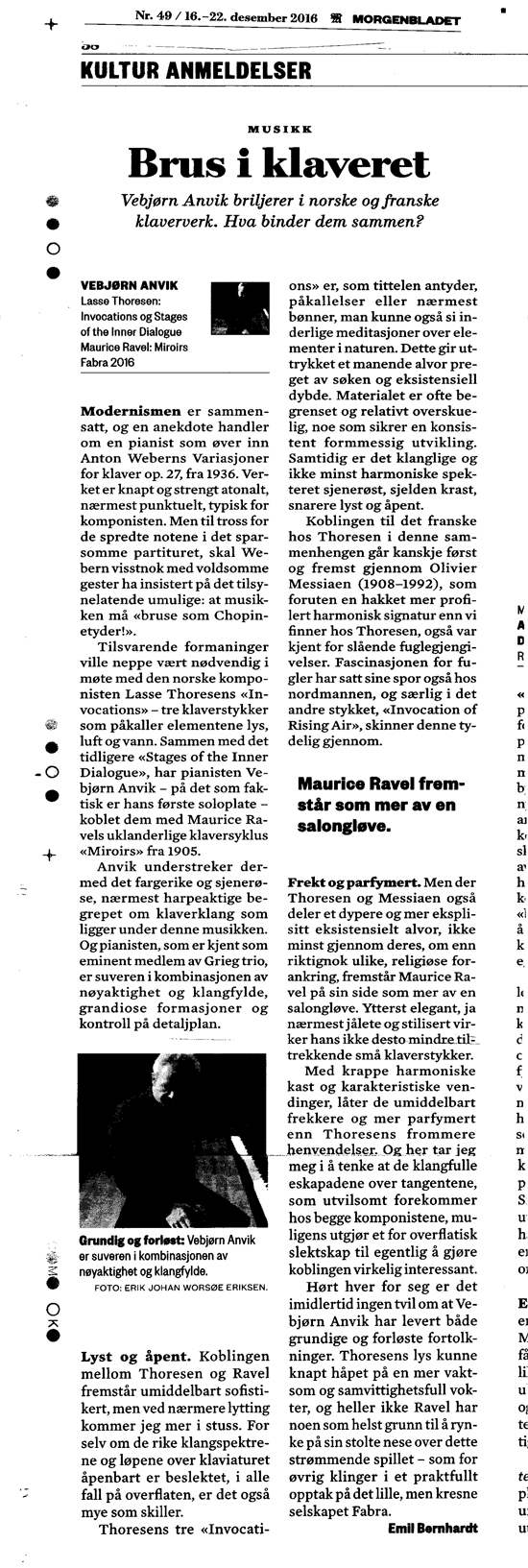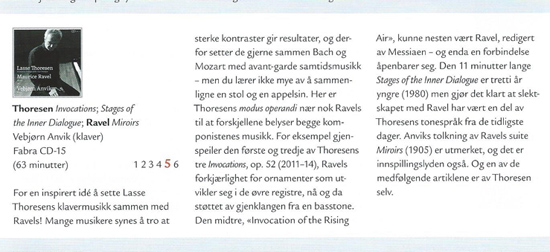
Klangkunst
Lasse Thoresen: Invocations & Stages of the Inner Dialogue. Ravel: Miroirs. Vebjørn Anvik, klaver. Utgitt på Fabra.
Vebjørn Anvik kjenner vi som pianisten i Grieg Trio. Men han er også en fremragende solo-pianist. Valget av Lasse Thoresen og Ravel er særdeles vellykket. Det er som om Thoresen har hatt Ravel i hodet da han skrev disse tre påkallelsene. Det er naturen som påkalles og omformet til klanger, rislende passasjer og triller. De kraftfulle trillene Anvik får frem hos Thoresen, er det bare å beundre.
Vi hører kirkeklokker i dalen, rislende, dryppende vann, lerkesang, lys. Fortolkeren gis forskjellig grad av frihet i de tre påkallelsene. I det siste stykket, Stadier i den indre dialog, er ørets oppmerksomhet vendt innover, som en kontrast til den avstand som de tre påkallelsene har. Det benytter en modus (toneart) av Messiaen, en komponist som forente natur og det spirituelle på en egenartet måte.
Ravels Miroirs (speilbilder) angår også natur, eller en fremmaning av natur: nattsvermere, triste fugler, en båt på havet, klokkene i dalen. Som Olaf Eggestad så treffende formulerer det i tekstheftet, er det både fjernklang og etterklang i Ravels instrumentelle malerkunst, der melankoli avløser enkel skjønnhet. Anviks Ravel-tolkninger er utsøkte.
Morgenbladet 16.12. 2016, Emil Bernhardt:

Klassisk Musikkmagasin 4/2016, Martin Anderson:

Klassekampen 17.10. 2016:

Fanfare Magazine, USA:
THORESEN Invocations, op. 53. Stages of the Inner Dialogue. RAVEL Miroirs / Vebjørn Anvik (pn) / FABRA 15 (62:51)
How wonderful that one should have the opportunity to further explore the magnificent music of Lasse Thoresen, for it was as recently as Fanfare 40:4 that I welcomed an all-Thoresen SACD on the 2L label played by flutist Maiken Mathisen Schau and pianist Trond Schau. There is some overlap: The 2L recording held one (the third) of the three Invocations as well as Stages of the Inner Dialogue. Here, we are offered all of the Invocations, plus Stages, all juxtaposed with a sterling performance of Ravel's Miroirs. In addition, one should note that Thoresen offers choice to his performers in terms of the combination of sections, emphasizing that there is room for more than one recording in this repertoire. Both Schau and Anvik are superb exponents, and as a result the releases are complementary in nature: Neither supplants the other. It is worthwhile noting also that there are a further 10 discs (one a Blu-ray Audio, Himmelkvad) listed on ArkivMusic that either contain some Thoresen or are Thoresen-only discs. Much is left to explore, then.
In an introduction by the composer himself, Thoresen traces his influences back to the likes of Messiaen, Pierre Schaeffer, and the Spectralists Gérard Grisey and Tristan Murail. He claims that Impressionism was "far from his mind" when he was composing the Invocations, but one easily hears a love of luxuriant sound. Both Thoresen and Ravel are concerned with symbols of Nature. Thoresen's three Invocations explore, in order, light ("Pristine Light"), air ("Rising Air"), and water ("Crystal Waters"). The clear implication is that the set is not yet complete, and we await, possibly with some impatience, an invocation of fire.
Composed in 2014, the "Invocation of Pristine Light," the first of the Invocations, shimmers with a constant movement. Anvik's performance shines because of his variety of touch and his crystal clarity; the music emerges almost as refreshing. The pedaling in the piece's final gesture is perfectly judged, a real testament to Anvik's attention to detail. The next piece, "Invocation of Rising Air" (2014/15) finds us experiencing the spaces between the notes as much as the notes themselves; as the piece progresses, birdsong is injected into the ongoing argument, bringing with it inevitable associations with Messiaen. The return to the peace of the opening section is beautifully managed. Anvik's touch is considered and takes in the extreme lower end of the dynamic ranger; the recording fully supports this dynamic range. The use of bell-like attack and simple octaves in the work's final moments makes for a most atmospheric effect.
It was Anvik who gave the premiere of "Invocation of the Crystal Waters" in Bergen in 2012 (it was composed in 2011). This is the shortest of the three Invocations and is divided into an "Aqualudium" (evocative, tending towards the atemporal) and "Aqua Fuga" (which as the description implies is based on the fugue). The cascades of notes that erupt from time to time in the "Aqualudium" are the closest this piece comes to Ravel; the contrast with the crystalline fugue is perfectly judged. Anvik's delineation of these final moments is beautifully managed.
A Debussy Prélude ("Des pas sur la neige") seems to hover over the opening of the earlier (1980) Stages of the Inner Dialogue, a piece based on a mode also associated with Messiaen. It is impossible to give a clear preference here between Anvik and Trond Schau; ideally both should be experienced. This work has a hypnotic side to it as it moves from dark to light and thence to a liminal region between the two, so much so that it flirts with Minimalism at one stage, skirting that form of expression before moving on. This is fascinating music that demands to be heard.
There are 66 recordings of Ravel's Miroirs listed on ArkivMusic, but there is always space for one more with a score as rich and variegated as this. Flying the relevant flag, and all recommendable, are Aimard, Thibaudet, Samson Francois, and Bavouzet, while Steven Osborne on Hyperion provides one of the finest of modern readings (and recordings, for that matter). The present performance by Anvik holds its head high, but it really comes into its own with this unique coupling. Both Ravel and Thoresen react to the natural world, but in fascinatingly complementary ways. Ravel is one step removed, whereas Thoresen represents total immersion. Anvik's realization of Ravel's exploration of the relationship between sounds and the space between sounds, something Thoresen also investigates in his work, is heard brilliantly in "Oiseaux tristes." The fluency of the opening of Anvik's "Une barque sur l'océan" is only equaled by its delicacy, while the spikiness of the opening of "Alborada del gracioso" contains not a hint of harshness; the music goes on to open out into clear light (still an Impressionist light, though: not the "pristine light" of Thoresen). Interestingly, Anvik's approach seems to be entirely pianistic, in the sense that he does not try to "imply" the instruments of the orchestrated version of this piece, instead reveling in the range of sounds available to a piano. Perhaps a touch more extroversion would have rounded off "Alborada" nicely; here he is just a touch studio-bound. But the magic of "La vallée des cloches" is retained in full.
Astonishingly, this is Vebjørn Anvik's first solo disc; it will be the first of many, on the present evidence. The venue, Den Gamle Logen, seems to have the perfect acoustic, and the sound is brilliantly captured by Fabra's engineers. The release is obviously available as hard copy; however, fabra.no also gives a selection of download options at various prices.
Colin Clarke
